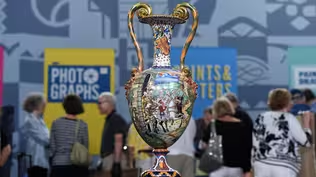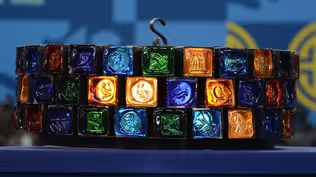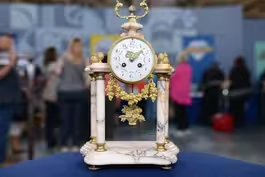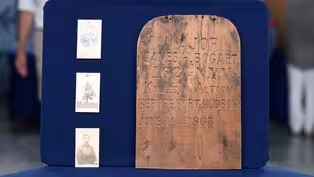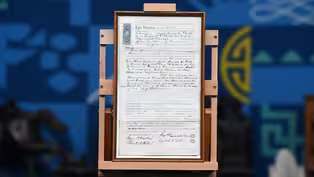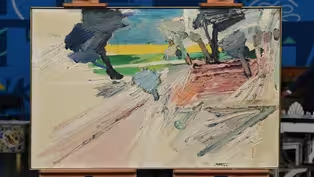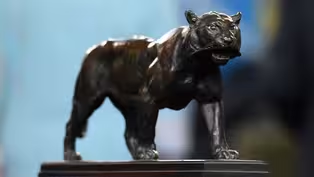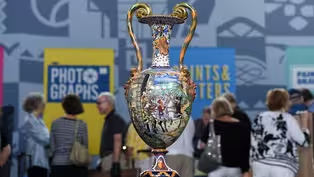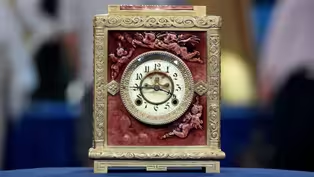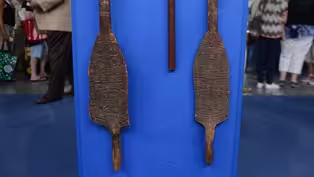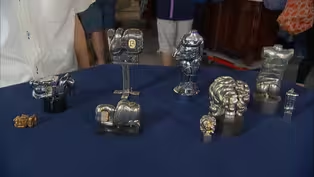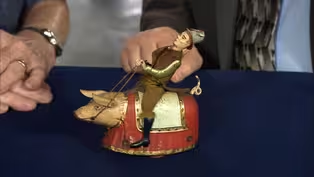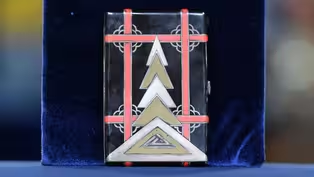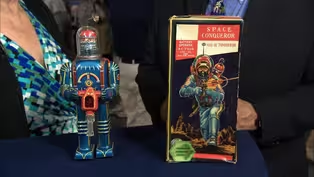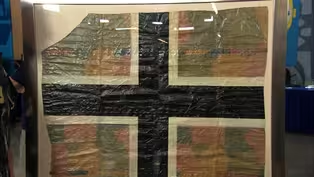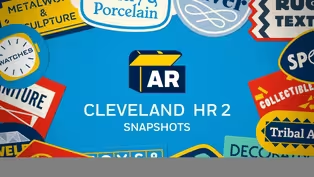

Cleveland, Hour 2 (2016)
Season 20 Episode 17 | 52m 59sVideo has Closed Captions
An Ohio stoneware match stand, Civil War grave markers, and a Manoucher Yektai oil.
Join ROADSHOW in their journey to Cleveland and learn about items such as an Ohio salt-glazed figural stoneware match stand, an 1863 Civil War grave marker group, and a 1964 Manoucher Yektai oil painting. Which find is valued at $65,000?
Problems playing video? | Closed Captioning Feedback
Problems playing video? | Closed Captioning Feedback
Funding for ANTIQUES ROADSHOW is provided by Ancestry and American Cruise Lines. Additional funding is provided by public television viewers.

Cleveland, Hour 2 (2016)
Season 20 Episode 17 | 52m 59sVideo has Closed Captions
Join ROADSHOW in their journey to Cleveland and learn about items such as an Ohio salt-glazed figural stoneware match stand, an 1863 Civil War grave marker group, and a 1964 Manoucher Yektai oil painting. Which find is valued at $65,000?
Problems playing video? | Closed Captioning Feedback
How to Watch Antiques Roadshow
Antiques Roadshow is available to stream on pbs.org and the free PBS App, available on iPhone, Apple TV, Android TV, Android smartphones, Amazon Fire TV, Amazon Fire Tablet, Roku, Samsung Smart TV, and Vizio.
Buy Now
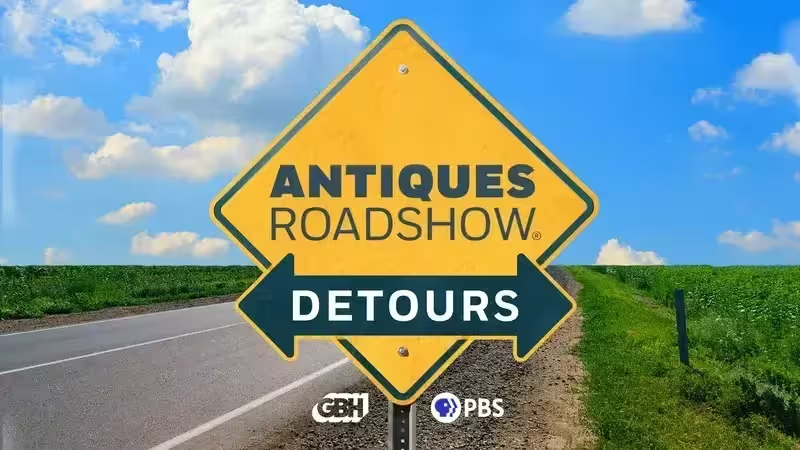
ANTIQUES ROADSHOW DETOURS
Ever wondered what happens to the treasures featured on America’s beloved ANTIQUES ROADSHOW after the cameras leave town? Host Adam Monahan tracks down the juicy afterlives of your favorite finds from PBS’s hit series.Providing Support for PBS.org
Learn Moreabout PBS online sponsorshipMARK WALBERG: Antiques Roadshow was on the lookout for treasures in the Buckeye State-- Ohio.
And you couldn't find anything smaller to bring today?
No, I couldn't, except it has another one the same size.
What?
Oh, wow.
♪ ♪ WALBERG: The Cleveland Museum of Art was a must-see attraction during our visit to Ohio.
There are incredible paintings, pottery, and statuary, works of art from all around the world on display, both inside and out.
Do you recognize this pensive guy?
It's The Thinker by Auguste Rodin, and it's one of 25 versions of this size in existence, though this one has the unfortunate distinction of having been targeted by vandals in 1970.
A bomb was planted that destroyed the piece's base and lower legs.
Those responsible were never caught.
A much smaller, though intact, bronze caught our attention back at the Cleveland Convention Center.
Check it out.
WOMAN: My grandfather was adopted by a fairly wealthy couple that traveled all around the world who gave it to him after... he inherited it, and it's just gone down the family line.
I've had it for maybe a year.
It's just been in my house, so... And can I ask you where in your house it is?
Well, you can see it's dusty.
That's why I'm asking.
So it's just been on the mantel.
And I haven't really done any research on it, so... Well, it's very clear, because it's signed right over here, "Barye," that it's Antoine-Louis Barye, who was a very famous French sculptor in the middle part of the 19th century.
And we see lots and lots and lots of these at the Antiques Roadshow.
Oh.
Every Roadshow we see at least two or three Baryes.
Yours is particularly nice; it's an interesting one.
The title of it is Marching Tiger.
And Barye was the first of what was called the animalier sculptors, sculptors who specialized in the depiction of animals.
And there are a dozen artists who came after him who specialized in animal sculptures, but he's the premier one.
And he did every kind of animal.
There's a lion devouring a crocodile.
Some of them are pretty gruesome.
Yeah.
And they were very popular in the 19th century.
There was a romantic idea about animals, and the purity and the truth of nature.
And they've sort of fallen out of favor, since we like more warm and cuddly kinds of animals, and dogs and horses or whatever.
And what's very nice about it is that it has a foundry mark.
And that foundry mark is right here-- F. Barbedienne, and it says "fondeur" here, "foundry" in French.
Barbedienne at this time was probably the most prominent foundry in France.
And in France at this time, bronze production in these foundries was phenomenal in terms of the amount of detail.
See where the stripes adjust in size there, and the clarity, the crispness of the casting, and just the subtleties.
It's really beautifully done.
What's so interesting about Barye is not only that he spawned a whole number of artists who worked in this animalier style, but he also spawned companies that made reproductions.
And when I say we see these at every show, it's because we see them in various materials, primarily white metal or spelter that are made to look like bronze.
And usually they're also called surmoulages, where they take an original Barye bronze and they make a recast or reproduction based on the original model.
And that's what we see all the time.
Yeah.
What's nice about your piece is that it's actually from the period.
And we can tell this with this little mark over here, the FB in gold, and that stands for Ferdinand Barbedienne.
Barye died in 1875, and his estate sold the rights to reproduce these bronzes.
You know, they're made in foundries, not necessarily in editions, but they were made.
And what's nice is that we know that Barbedienne bought the rights in 1876, and then the rights were given to another foundry in 1892.
So this puts a very nice, firm cap on the date, and it makes it from the period right after his lifetime.
Did you ever have it appraised?
I know it was appraised in the 1950s, was the last time.
And it appraised for $100.
$100.
In today's market, a retail price on this would probably be about $10,000.
Oh, my gosh, really?
Yeah.
Wow.
I had no idea what it was, and here I'm letting it collect dust.
What would you insure it at?
I would insure it for something in the $15,000 range.
WOMAN: I collect Art Deco.
And I would go to estate sales, usually on the weekends.
And I went to this one house sale, and I really loved it.
And so I bought it, and I paid $65 for it.
I've had it in and out of a drawer ever since.
And how long ago was it that you bought this?
About 1995.
It's a lovely piece.
And you are correct.
I mean, it is typically Art Deco.
The black, the red, and this sort of olive green color.
It is silver on the outside here.
And you've got this sort of foliate motif here.
When I saw this, immediately, especially because of the enamel work, I thought it was by an important maker from France named Paul Brandt.
And it is.
So I found the mark inside the case, and it is by Paul Brandt.
But there's also another interesting history which I know you know as well.
And what I'd like to do is show the inside of the case.
Many times these cigarette cases have dedications inside of them.
The two names that are on here are Roger Williams and Louis Yancey.
It's engraved July 27, 1929.
Now, Williams and Yancey were pilots, and they left Old Orchard Beach in Maine heading for Europe.
And they broke the air record in 1929, which is the year that this was dedicated.
So it says "24 votes for honey."
And I tried to do some research to see if there was any record of that, but I don't know for sure.
So that's an unknown factor here.
Yancey was also very much involved with charting the course.
And early on in the course they had to fly blind.
They were in cloud cover for 20 hours.
So he really was ahead of his time.
So the piece would date from the late 1920s.
It's engraved 1929.
There's another dedication from the 1930s, so it's right around that same time period.
It's a wonderful piece of history.
There's sort of two values here.
As a Brandt cigarette case, because he was known for enamel work and lacquer, at auction, a piece like this would probably be in the $2,000 to $4,000 range.
But add to this the aeronautical background, I would expect at auction you could probably expect somewhere between $6,000 to $8,000... You're kidding me.
At auction.
I'm not kidding you.
It's such a great piece.
It's got everything that you want.
It's got history, it's got a great maker, it's Art Deco.
This hits all the bells.
It sure does.
That's marvelous.
I'd take up smoking, seriously.
If I had this, I'd take up smoking again.
Well, my great-grandparents were married in 1910.
Okay.
And that was given to them as a wedding gift.
Okay.
Realistically, in a shop, maybe $100, something like that.
World War II's over, soldiers return, they get married, they buy a bungalow, they have kids, they've got no money, but they want cool, decorative stuff that's pretty and inexpensive.
For some reason, Spain was big in the '50s.
He's getting ready to take a picture of this.
Well, I'm an avid believer of an artist named Charles McGee.
And one weekend I went to an estate sale, and I found this one here, and I thought it was a print.
The person who sold it to me, he sold it to me for over $1,000.
And I said to myself, "Since it's a print, that's a lot of money," but I wanted it so bad, so I bought it for $1,000, I gave it to him.
Then I found out later on it wasn't a print-- it was an original piece of art made out of graphite and charcoal.
And I don't know more than that about it.
So Charles McGee was born in 1924 in South Carolina.
Mm-hmm.
And at the age of ten, he came to Detroit, which would be a city that would become very important for him, and likewise he became very important for the city.
In 1969, he put together an exhibition called Seven Black Artists, which was very important in terms of the history of African-American art in Detroit.
It was a seminal exhibition with a lot of important artists, including himself.
After that, he even went on to start his own gallery, and in 1995 he had a one-man show dedicated to him at the Detroit Institute of Arts.
So he really became a fixture in Detroit.
Now, that's just a little bit about him.
And by the way, he's still alive right now.
He's 90 years old, and he's still working.
So when we look at this painting, what we see is something that has a lot of emotion to it, and it speaks a lot about love and caring.
What do you think the value might be today?
I have really no idea at all.
I have no clue.
I couldn't even begin to think about what the value would be.
Because I'm not even sure when it was really drawn, so...
Right.
Well, it does look like it's probably from his '60s, '70s period.
Okay.
The value that I would put on it today for an auction estimate-- it's a large work-- would be $4,000 to $6,000.
Okay.
All right.
Wow.
Well, that's an improvement.
MAN: This clock was given to me about 15 years ago from my grandmother...
Okay.
...who received it when she was right around 17 years old.
Right after her mother passed away, her father went out to a yard sale, was just going to purchase a gift for her, and this is what he came home with.
However many years later, back in early 2000, I was moving into a home, and I had a nice mantel, and she said, "You need a clock to put on that mantel," so she gave me this, and that's where it sat.
I'll bet you've enjoyed it.
I've loved it.
It's a great clock.
Yeah, it's a pretty clock, isn't it?
It's very pretty, it's very heavy, it's probably about 25 pounds.
It's very solid brass with, as you can see, the inlays on it.
Do you know anything about the clock?
I do not.
I've not found any markings on it, on who has made it or, you know, where it came from, or its age.
I'm assuming with it being an antique when my grandmother received it, it probably is over 100 years old, or thereabouts.
So that's pretty much all that I know about it.
Well, that's a good guess, it really is.
Because that's about how old the clock is.
The clock actually was made by the New Haven Clock Company.
They're the folks that made the mechanism.
And then they made the dial.
The clock is an eight-day clock.
I don't know if you run it or not, but it does strike on the hour and half hour.
It has what we call an outside escapement.
When the clock is running, that gear right there in the center turns.
And it gave you some motion right there on the dial.
It was actually an added feature that New Haven, the manufacturer, used or offered in their clocks.
But what they did is they went to the J. and J.G.
Low Tile Company in Chelsea, Massachusetts, and had these tiles produced.
And then they would inset these tiles in this brass frame, very aesthetic period clock, with these beautiful tiles with the putti.
You can see the putti here.
There's additional ones on the side panels also.
It's paneled on three sides.
And then you have the panel up on top.
Very fluid motion to the design on the top.
Very pretty clock.
As far as a date, they usually date from the 1880s, 1890s.
And it's sort of the tail end of that Victorian period, but they were moving more toward the Art Nouveau look.
They are nice clocks.
Looking at it, it's just a pretty clock.
These will retail for usually about $4,000... Wow.
...to $4,500.
Wow, that's great.
WOMAN: I came by it from my grandmother when she had passed.
I just latched onto it, I guess.
It's always been around, and nobody paid much attention to it, and I've always liked it.
It holds a special place in my heart, because I began as a porcelain dealer in '72, but about a year later I started selling pottery.
And my first piece of pottery was a piece of Fulper pottery from Flemington, New Jersey.
And this is a piece of Fulper pottery.
Oh.
I bought it for six dollars in an antique shop down by the Jersey shore.
You liked it, huh?
So... but this is not just a piece of Fulper pottery.
It's a good early piece of Fulper.
Fulper pottery started in the early 19th century as a... they were making stoneware crocks and butter churns and utilitarian pieces.
And in 1909, when the pottery craze was kicking in throughout America, John Martin Stangl, who was a member of the family, German, changed them from a traditional pottery to an art pottery in '09.
Fulper straddled the line between handmade one-of-a-kind Arts and Crafts pottery and mass-produced production pottery.
And the way they did that is the shape itself... this is a really beautiful Chinese-inspired form with a beautiful glaze.
The shape itself is molded... Oh, it is?
...so they made a number of these.
But the glazes are different on each one, especially early on.
And this piece with this mark, this mark is the earliest mark, about 1910, 1911, maybe as late as 1913.
And pieces from this period, particularly the artists, if you will, lavished a lot of attention on the glazing.
So while this is a mass-produced molded pot, it's of the highest order.
And consequently, people who collect Fulper pottery look for pieces with that early rectangular mark.
Oh, okay.
The pricing structure... Fulper's been dead for the last seven or eight years.
I mean, you couldn't give Fulper away.
About a year ago, a major collection started to come to market.
And it came in 15-, 20-piece lots.
And because of the quality of that collection, it revived the Fulper market.
I think it's interesting to talk about, because why do markets rise and fall?
People lost interest in it, but suddenly regained interest seeing how fine quality Fulper could be when the best pieces surfaced.
And two years ago, this piece was bringing $800, $900.
One of them sold recently at auction for nearly $4,000.
I don't necessarily want to say this is a $4,000 piece.
You can't?
I think it's safe to say it's worth between $2,500 and $3,500 on today's market.
Oh, okay.
But a really good multi-flambé glaze piece.
And you look on this side, you'll see one thing they were known to do-- not only changing different colors working through the surface, but also different textures.
So high-glaze flambés, crystalline flambé, and a matte all working together.
And that's what they did best when they were hitting their stride.
Uh-huh.
In about 1910, 1912.
1910?
Show your puppy.
My first apartment that I had when I was 19 years old, like, a couple weeks ago, there was an older gentleman that lived in the apartment next door, and he gave me this lamp.
It is a boxing poster for boxers that boxed in Cleveland back in the day.
WOMAN: I got it from my cousin's estate.
And it was one of his toys?
Yes.
He got it for his 15th birthday.
It's called Space Conqueror, and it was made in the '60s.
Right.
It was a great space toy, which were very desirable then, and even more desirable to collectors today.
Box is great, and we like them in this condition.
Now, oftentimes we'll ask somebody what did they pay for something.
But you didn't buy this, but somebody bought it.
And you know what they paid for it?
Two dollars and 97 cents.
Well, I guess you'd like to know what the value is now.
Yes, I would.
Well, why don't we round $2.97 and call it three dollars?
And then we'll put another zero behind it.
Really?
Yes-- $3,000.
My golly!
Oh, my golly!
I can't believe it.
At auction, that's what it should bring.
Okay, thank you very much.
Thank you for bringing it in.
Thank you very much.
MAN: When I was in my... sophomore in high school, I went to get a haircut.
And the barber had these behind the counter.
And he brought them out and wondered if anybody wanted to buy them.
So I says, "Yeah, why not?"
I wasn't married, I didn't have anything to do but go to school.
So we arrived at a price, and I took them home, and I've had them ever since.
So what did you pay for them?
It was either eight dollars or $20.
So at least... the max investment is $20.
Yes, it is.
We've shown them in our house for all of our married life on a wall in the family room.
Well, what have you told people they were?
Well, I said these were boat oars, I thought, and maybe even for real shallow water they could be used in the mud.
And then this I thought was a war club.
All right.
This group of objects are all from the Marquesas, which is Polynesia, in the Pacific.
Okay.
And I can tell you now that these pieces... let's start first with these paddles.
And I want to point out the carving we have down here, and I've never seen a paddle that has this extension on the bottom.
And actually it's a functional thing.
It's to push off the rocks.
All right.
So this was made... definitely made to be used.
You have these two Marquesan figures up here, and they protect the individual that owns the piece.
We see the same thing on the club.
This form really dates back to Cook's second voyage, 1772-1775.
Now, this one is a little bit later.
I think this is late 19th century.
It certainly started out as a war club.
And again, we see the head.
This would protect the individual holding this piece.
Now, the wood is an iron wood.
The wood is called toa, okay?
Toa, which also means "warrior."
Now, the club itself is called U'u.
And as we said, we've seen this form before.
It is started out as a club, but then it becomes more ceremonial, an indication of status and power in the group.
And I can tell you that your investment probably paid off.
Oh, good.
These two paddles, they would be $500 to $700 each.
And then this club in the center is $1,500 to $2,500.
Okay.
And those would be good retail prices.
Okay.
This tea set was owned by my great-uncle.
He was the superintendent of the military school in Omsk, Siberia.
And given to him by his students, because his students really liked him as a teacher.
And very shortly after this gift, the students and the faculty came to him and asked him to help them escape from Russia, because the Bolshevik revolution was taking place.
Yes.
The Colonel, Anthony Seletsky, put together a freight train, had the families of all the students and the officers dress as Czech peasants.
Okay.
And then they took the train from Omsk to Vladivostok.
All the way across?
All the way across.
It was a very difficult journey.
Then from Vladivostok to Japan.
And then they went to San Francisco, and finally to Baltimore.
Right.
And the tea set traveled all of that way as well.
The tea set came with them in a trunk in the train.
There is an inscription on the front of it which is, in Cyrillic, "To the respected "Antony Vasilyevich Seletzky, from his most grateful students "at the Omsk Officers School in Omsk, Fourth of June to the Fourth of October, 1916."
So it's quite clear they held him in very high regard.
The tea set itself is made by the Second Artel.
In Russian silver making, and in agriculture and other areas, actually, there are these small collectives put together which became known as the artels.
There are elements to this tea set which I think very clearly demonstrate what became a pan-Slavic style that took influences from Europe and elsewhere and made it into something quintessentially Russian.
The rather lovely bird form here is a great example of pan-Slavic design, as is also these triangular motifs here, which are very atypical of European design and something that you would immediately identify with Russia.
The spacers here are actually mother-of-pearl, which I think is quite interesting.
And if I just tip the teapot back, I'll show you the Second Artel mark.
It's just simply a 2, and then a letter A right here.
That is above what we call the Second Kokoshnik mark, which was the silver guarantee mark between 1908 and 1926, which dates this quite nicely with your family history of 1916.
It probably was made in 1915 or 1916.
It's got a nice sort of textured ground as well.
Now, the fact that it was a gift to this gentleman from his students is of itself, I suppose, not as fantastic a story as the one that you later told me about him helping them to escape.
And I think it's worth pointing out that while the great story of them bundled in these train cars, trundling along the Siberian mountains, really does help inspire one's imagination, it's not necessarily something that we can connect with this particular object.
That's true.
We need to take it at face value and understand that this is an inscription given to a very well regarded instructor.
So with that all said, I think that if this was to come to auction I would estimate it at between $2,000 and $3,000 for the set.
Very good.
Very, very good.
That's more than I thought.
I appreciate that.
Yeah, that's well worth leaving Russia with.
You couldn't find anything smaller to bring today?
No, I couldn't, except it has another one the same size, so I only brought one.
Wow.
The other one has castles as opposed to the tents that this one has.
And are they both the same size otherwise, everything, the same model?
Everything the same, handles the same, everything.
Great-- well, I'd say you don't have two, you have a pair.
Okay.
Tell me a little about how you got them.
Well, they came through my father.
Many years ago, after the Second World War, one of the Limoges factories opened a plant, and they were going to produce flatware here.
After two years it failed.
The manager went back to France and he sold these to my father.
And do you have any idea what your father paid him for them back then?
I don't think very much, but I don't know.
Did he bring them from France with him when he came?
Said he did.
Well, I could believe that, because these, and I'm talking about a pair of them, would have been made kind of 1880.
And they were made at the height of the Renaissance Revival period.
And at that time, wealthy people, particularly in North America and the United States, were kind of into all things from the Italian Renaissance.
And there wasn't enough of the real sort of 16th, 17th century stuff to go around, so Italian manufacturers made copies, very often authentic copies, of original Renaissance objects.
And there was a company in Florence that made and decorated what we call majolica ware.
As this is of Italian manufacture, we would call it maiolica, spelled with an "I" in the middle.
It's often referred to as majolica, which is a Northern European English Anglicized way of pronouncing it.
This is very typical of the work of a company in Florence run by Ulisse Cantagalli.
And Cantagalli really specialized in authentically reproducing Italian Renaissance maiolica work.
And everything is done the old-fashioned way.
The earthenware is tin-glazed.
This white background color is achieved by the action of tin oxidizing in the kiln.
And then it's painted by hand with these exotic scenes.
In this case he's chosen a Medieval battle scene.
You can see the scene continues on the back.
I particularly like these handles.
These are... we would call them gorgon heads, the handles.
And they're finished, as you can see, in red luster.
And this lustrous finish is also a characteristic of Cantagalli, and indeed a characteristic of Italian Renaissance maiolica.
But everything about it is great.
We know it's by Cantagalli, because on the bottom there's a blue painted cockerel, and that's the symbol of Cantagalli's workshop in Florence.
We would call this an urn, or a pair of urns, and they were really designed purely to be decorative, to sit on a large pair of pedestals near an entranceway or something like that.
And if you just had this one, and it came in, and came to auction, it could bring as much as $2,000 or even $2,500.
I'd put it in that range.
But because you have a pair, they're actually worth more than twice that.
So I'm going to say a pair, at least $5,000, and perhaps as much as $7,000 at auction.
Okay.
Well, thank you, and thank you for telling me what they were.
I've been trying to figure it out for years.
Tribal Arts?
This goes to the Tribal Arts table.
It's a basket, Indian basket, okay?
Oh, thanks.
I love this painting.
Yes, she is, she's beautiful, yes.
Okay, perfect.
Prints and Posters for the two.
MAN: This is from World War I.
We had this in a burlap bag, stored away in a hope chest.
A couple times I would take it to school for show-and-tell.
I knew that it was the German Iron Cross from a German airplane.
Unfortunately, I don't know what type of airplane.
I presume a biplane.
Sadly, we probably never will know.
We certainly are not going to be able to find out which type of aircraft it is, because there are no clues inherent to the material that tell us that.
Okay.
One thing I can tell you is that the camouflage pattern that you're looking at here is called lozenge camo.
And that's a very distinctive German camouflage pattern that came out late in World War I, and they used it across a number of different aircraft.
All right.
We find lozenge camo a lot.
Anytime one of these planes would crash, the Allied servicemen were there with pocketknives cutting it up into little pieces for souvenirs.
Yes.
And so you find a lot of pieces that are five, six, seven, eight inches, maybe, if you're lucky.
Rarely, though, do you find a great big complete panel with one whole wing insignia on it, or fuselage insignia like you have here.
The small pieces are desirable.
People collect them.
But this is what they're after.
I would anticipate seeing a retail price for this in the neighborhood of $6,000 to $7,000.
Wow, that's amazing.
I brought in a deed that was from Monroe, Michigan, and it was signed by General Custer and his wife Elizabeth.
And where did you find this?
I found it through a dealer in western Ohio about 15 years ago.
Okay.
It's such an interesting piece to me as a books and manuscript specialist, because it really captures what we love about manuscripts.
And actually it's a real estate document.
It's a document recording the sale of a piece of property.
The Custers are selling a piece of property to somebody else, which seems very prosaic.
But actually, beneath this document is a really rich love story.
They met in 1862, and they immediately fell in love, but her father did not approve of him and would not let them get married until after he had proved himself at the Battle of Gettysburg.
Finally the father relented, they were married, and she spent the rest of his life traveling with him at most of his military posts.
And then after he died, she really dedicated the rest of her life to preserving his legacy and his memory.
The reason we know who he is, the reason why he is such a memorable character in American history, is because of his wife and the books that she wrote and the lecture tours that she did to spread the news about him.
So this document is executed in 1870.
And George and Elizabeth Custer are selling four plots of land.
And these are basically her inheritance.
Her father has died about four years before this time, left her some land in her home town, and they are selling this property in early 1870 for about $300.
And one of the reasons they might be doing this at this particular time is that a few years earlier he had been court-martialed and put on suspension for a year.
Do you know the reason he was court-martialed?
He made a wild ride across Kansas to see Elizabeth.
Yes.
He went AWOL to see his wife.
The year he spent on suspension probably did mess up their finances a bit, and so they're at this point where they are selling some of the land that she has inherited to help them along in their debt.
That's what I felt, yeah.
What I really like about this document-- and this is the only document I've ever seen like this in my career-- is that not only is it signed by George, "G.A.
Custer," right here, Elizabeth also signs.
Now, I have never seen the two signatures on the same document.
In the pantheon of Custer documents, the military ones are the most valuable, and generally the domestic ones would be less interesting, but I think that the combination of these two signatures really places this above its peers.
Have you ever had this appraised?
I have never.
What did you pay for it when you bought it?
I'm pretty sure it was around $1,500.
And how long ago was that?
Probably about 15 years ago.
And I chased a guy seven years to obtain this document.
Why didn't he want to sell it to you?
I'm not sure, but finally one day I called and he said, "Yeah, Mom and I would like to sell it."
Well, at auction, conservatively, I would estimate this document at $3,000 to $5,000.
Given the romance of the story behind the document, and the fact that this is a critical moment in their marriage, I would expect it to do as well or better than that.
Yep.
I love the way he signed it with his flamboyant signature.
Well, that guy was a character.
WOMAN: We got it about 35 years ago.
And we know that it's from Akron, Ohio.
Okay.
That's Summit County.
And there were about 30 potters in Summit County.
And I don't know which pottery that came from.
And I bought it from a man whose father had worked at a pottery, but he wasn't sure which one.
I gave it to my husband.
Yes.
And my husband didn't like it right away, because he thought that the bird wasn't very nice.
And I said, "Oh, my goodness."
I said, "It's supposed to be upside down like that-- it's folk art."
Right.
So he decided that he liked it.
I paid $75 for it.
Okay.
And we've never had it out of the house since about 1980.
He charged you $75.
Did he know what he was selling at all, or... Well, I think he was kind of down and out.
Okay.
He had started... he said he needed a $100 bill.
And I said, "Oh, I can't pay that."
And so I got him down to $75.
Okay.
And we had been buying some other local pottery.
And I thought it was worth it, because it was different.
This piece is one of the most sculptural, most folky, most exciting pieces of pottery, of folk art, that has come to us in years.
It has everything.
It's kind of the soup-to-nuts piece of sculpture.
It is Ohio, I feel.
You have two men in front of this stump, right?
And I love this guy here with the moustache, the handlebar moustache.
Isn't he great?
And that helps to date the piece.
You look at the clothing, right?
There's this wonderful pig, which has survived over... look at... isn't it a cutie?
I didn't even see that.
Honestly?
No.
I did not see that pig.
And you have this log in front of it that's hollow.
The other gentleman is over here with his moustache, his gun, his rifle, a little bit snapped off here, but it's a glass half full-- you have to look at how much survived.
And then in the middle, I'm not sure what that really is.
It almost looks like a deer.
If you think about it, that's a deer's head.
But then... do you think it's a turkey?
Either a turkey or a pheasant.
Okay, but it's hard for us to really pin down.
It dates from about 1865 to about 1895.
Because you can tell by the clothes?
Tell by the clothes, tell by the type of pottery.
They were making this type of pottery in the 1890s.
And the condition is excellent.
You think about how easy it would be for one of these limbs to break off.
So it's covered with this brown slip which we often call Albany slip.
And cobalt blue.
It's been really baked, so it has... it's textured, it's colored.
And then the base is dotted with dabs of brown and blue, which have turned more green because of the firing.
And this is really a piece of stoneware.
So stoneware has very high temperatures.
And the only colors that could withstand that 2,100-2,200 degrees of the kiln were the browns and the blues.
And even in the case of this, the blue got very textured.
But overall, it is a piece of great folk art.
It is... don't you think?
I mean, it's all the things... Oh, I love it.
The things you liked about it...
I love it.
...I just love about it, we all loved about it at the Folk Art table.
Any idea of value?
Maybe like $800.
Okay, I'm going to make you very happy, then.
I think that this piece at auction could have an estimate of $10,000 to $15,000.
I can't believe it.
WOMAN: I got them from my house.
I bought the house, and I found them downstairs on a shelf.
And what did you think when you first unrolled them?
I thought they were pretty amazing.
They looked original.
Wasn't able to find out a whole lot.
I learned a lot about the Pullman industry.
Okay.
They're fascinating.
First of all, let's talk about what they are.
They are original ink drawings, actual technical drawings, engineering drawings.
And here we can see this particular box freight car was built by the Pullman Company, Pullman, Illinois.
And Pullman, as you know, they not only built cars, but they also had a planned community in Illinois, and they also worked managing a lot of the railroad systems.
So this is obviously a technical drawing for a boxcar that they were going to either build or propose to build.
And plus you have how many other drawings here?
There are a total of 17.
Seventeen.
Yeah.
Many of them have dates on them, but most of them seem to be from 1900.
We could talk a lot about Pullman and their communities and the cars that they made, but the reality is, these drawings transcend the value of the connection to Pullman.
Yes, there'd be some people who would be interested in it, but the reality here, these are fantastic Industrial Age drawings.
And that's really where the market is.
And this is a great portrait of a boxcar.
And it's not a blueprint, it's not a Xerox, it's not computer-aided design.
It's somebody who took the time to draw every line of this by hand.
So we put this in a context... frame it and put it in a decorative environment, put it in somebody's home with modern furnishings, and we now have a wonderful piece of art.
And that's really where the value lies in these drawings.
Honestly, looking at them, I think, unframed, we'd be talking about, for the kind of uninteresting ones or more kind of technical detail ones, maybe somewhere in the $300 to $500 range.
But for the fully formed cars, I think we're easily in the $800 to $1,200 apiece.
And then framed up, you could command, in a retail environment, maybe as much as $3,000.
Wow.
So looking at the archive, I mean, they're great.
There's some just really fascinating details.
Every little rivet, every little bit of detail, is drawn here.
I think if I was to put a number for retail, I'd say easily $10,000 for them unframed.
Wow-- okay, for the whole set, then.
For the whole set.
Okay, wow.
I think they're fabulous.
And you can go to the Cleveland Museum.
Actually there's a friend of ours who has an exhibit on right now you can see in the museum that has the same kind of landscape.
Around $300-$500.
It is pretty.
The appraisal that you had done 14 years ago was a fair market appraisal for sale, or was it an insurance replacement value appraisal?
Fair market.
It's a Moro armor, after a sort of Spanish pattern for the helmet.
And it's probably late 19th century.
WOMAN: This painting was a gift to my father upon his graduation from Heidelberg College in Ohio.
I did a little research on it.
All I know is it is New Mexico area, and it's Pop Chalee, and that she was a female artist.
Her name was Marina Lujan, Pop Chalee.
Oh.
And she was from Taos Pueblo.
She was born in 1908, and she was well known in the Hollywood circles, well known in the Taos social set, and became a very important artist.
The difference between this painting and most of her paintings, they're usually horses or deer in very stretched out sort of Art Deco looking artwork.
This is Taos Pueblo, where she grew up.
You can tell because of the three stories.
Taos Pueblo is the only pueblo that has three stories on it.
And the clothes are typical of Taos.
It's hard to tell exactly when she painted this.
She painted well into the late 20th century.
It's a great painting.
It's a good size painting.
If this was in a gallery, I would expect a price tag of $3,000 to $4,000 on it, very easily.
Oh, exciting.
Very exciting.
It's very nice.
Oh, thank you.
MAN: I have my great-great- great-uncle's wooden headboard from when he was killed in the Civil War.
He was killed during the Battle of Port Hudson during a charge.
There was an artillery shell that went through his hip, and he died instantly.
And he was supposed to be sent back to New Orleans, but nobody got him, so they ended up having to bury him on the battlefield.
And they carved this headboard, and then sent off a letter to his family to come and get him.
So how did you end up with the headboard itself?
So my grandma is the family genealogist.
And she knew that I had an interest in the Civil War.
So in 2000, she gave it to me, so... Well, during the Civil War, so many casualties, it was necessity first during the Civil War.
And so they wanted a headboard because he was an important person to them.
You can tell he was important, because it's not just written on it, it's nicely carved into the board.
How did he get back home?
His aunt came down from Albany, New York, and took him back, and then he was buried in Albany, in the Albany Rural Cemetery, so...
But this one would have likely been the one that was used in Port Hudson.
Yes, correct.
During the temporary time.
Correct.
He has a permanent marble statue that his family created back in Albany.
Well, this is a very moving group of pieces, because not only do you have the headboard, you can kind of see a progression.
This is him early in the war.
This is him later in the war.
Him and his buddy, ready to rule anything.
Right.
One cannon shell, and that all changes.
This is what?
This is... when the family went down to pick him up, they brought a photographer and took a photograph of his battlefield gravesite before they removed his remains.
And when did they move his remains back to...?
It was February of 1864, so about six months after.
So it gives you an idea what an important man this man was and what they thought of him because, if you notice, in the picture, they actually built a little fence around his grave.
Right.
Since he was moved from there, we know that's within that one year.
There was a lot of things going on in Port Hudson, Louisiana, within that year, but he was important enough they took time to make that fence.
I'm curious to know how rare the battlefield wooden grave markers are.
In 1863, they'd be common.
Okay.
But weather did away with most of them.
Very few of them survive, and most of them that are are in museums.
Okay.
It's very rare that you see an original from the Civil War.
Have you ever had the group appraised?
No, it's just been a part of our family, and I never really reached out to anybody to see what it was worth.
Well, it's one of those things, you see muskets, you see swords.
It's easy to say, "That will bring $1,000."
With something like this, it's unique.
And it's wonderful that it's still in the family, but you have to insure things in the family.
If I were going to insure this group, I'd insure the group for $5,000.
Oh, wow, great.
Thank you.
This is a clock that I acquired from my parents.
It's brass and marble.
The clock originated from Budapest, Hungary, a number of years ago.
My father was an Olympic skier, and my father skied for the Hungarian Olympic team in 1948.
And after the Olympics, the entire Olympic team defected from St. Moritz, Switzerland, which is where the Olympics were held.
So when my father defected, my father's mother wanted to follow and, you know, come to the United States also.
But it didn't quite work out that way in the beginning And so my father was arrested, and my grandmother and grandfather were incarcerated.
But through some negotiations, they were set free and my grandmother decided she was going to come to the United States.
So she took some of her belongings and had them smuggled out of Budapest, which had become a communist country, to England.
Once everything arrived in England, and at the time I wasn't sure who, but I found out later it was a cousin, because my father was an only child.
So my father came to the United States, my grandmother came through the underground, and they wanted to get this stuff back from England.
And there was a lot of discussion because the cousin didn't want to give any of this stuff up.
So after my grandmother passed away, my father, through communicating with the cousin, finally convinced him to send something that had meaning to my father.
You know, something that reminded him of his parents.
And it turned out to be the clock.
Six years ago, my mother passed away and my father finally said, "If you want the clock, you can have it."
Well, this clock is of European origin.
Okay.
Probably made about 1880.
Nice.
They made these clocks for about a 30-year period, up until the First World War, really.
They were very, very popular clocks.
When you ordered clocks like this originally, oftentimes you could buy them with side accoutrements, whether they be candelabras or vases.
We don't know whether this clock was originally purchased that way, but you had that option.
Right.
The base is marble, columns are marble.
Obviously built for show.
The case itself and the decorations are brass and designed to run eight days.
Very, very good quality.
Probably either Austrian or French made.
Okay.
The reality is is the movements are very, very similar and the companies that made them were making clock movements for people that went ahead and cased them themselves.
Is there any way to find out through the serial numbers where it really came from?
There is, but it really doesn't affect the value of it.
What's really important is the period in which it's made, and the fact that is has that circular-shaped movement that runs eight days, strikes the hour on the hour, and also strikes once every half hour.
When a clock collector looks at a clock like this, that's really what they want to know.
They want to know it's of that quality from that period.
Okay.
When people buy clocks like this, they want that visual, "Wow, that's a great-looking thing."
Right.
And that obviously has that for you.
It's got the wow factor.
You can see... you can see it in your eyes, you light up when you talk about it.
They made a lot of them.
So, in reality, if you were to go to replace this clock and you're going to a high-end retail shop, or just a nice retail shop in a local city like Cleveland, you would expect to find this clock priced at around $1,200 to $1,500.
Okay.
That's more than I thought.
You brought a fascinating painting into the Roadshow today.
And I believe it's by Manoucher Yektai.
What do you know about the artist?
I don't know much about the artist at all.
It was just a painting that was hanging in my grandmother's living room.
My grandmother passed away in 1998.
Right.
So the house was left to me and my sister.
I just took it off the wall to paint the walls and stuff, and I happened to notice that the price tag was still on the back of the painting.
And it was from 1964, and it cost $2,500 back then, so that was pretty pricy in 1964.
So I kind of... me being a bachelor, I kind of stored it away, because I didn't want it to get damaged or destroyed or anything, you know, watching a football game or anything like that.
Well, I think that was a good plan.
And was your grandmother a collector, did she collect other things, or...?
I don't know if you could say she was a collector.
She has a lot of paintings, big paintings.
There's a couple more that are, like, bigger than this that I couldn't fit in my car.
This is one I could fit in my mom's car, because I couldn't fit it in my car.
I was very excited to see this when you brought it today.
Oh, thank you.
And the artist is fairly rare.
He was Iranian, and he was born in 1922, and is still alive.
Yeah, I read that, yeah.
He, of course, began his study in Iran at the University of Tehran, and then he spent some time in Paris.
And he's greatly influenced there by Matisse and Cézanne.
And so colors like you see in this painting, I think, are very much reminiscent of what he was learning in France.
And then by 1947 he comes to New York and begins his study at the Art Students League, where a lot of young artists were studying.
And early on he was recognized for his skill in painting.
He was already beginning to show at Grace Borgenicht Gallery, which was a prominent gallery in New York at the time.
And he was showing along with Joan Mitchell and Milton Avery, and by the '50s he's showing with de Kooning and Jackson Pollock.
So he was really among good company.
The critics of the time considered him one of... or at least associated with the New York School, which included Pollack and de Kooning and others, and that he was one of the abstract expressionists.
He, however, felt that he was not totally abstract expressionist, that he was interested in both abstraction and realism.
And so he would incorporate realistic elements in many of his paintings.
So, for example, in the early '50s, a lot of them have still life components.
Sometimes they're figurative.
And in our case, we have a landscape.
So that is the combination of the realism and the abstraction.
In terms of the painting itself, he, of course, was very interested in texture.
And you can see the wonderful impasto that we have on this painting.
It's absolutely incredible.
When you have heavy impasto, often that can be somewhat dangerous, because it can lend itself for the paint chipping.
So that's not unusual for a painting of this age.
And as you mentioned, it was done in 1964.
So it's been around a long time.
It's in its original condition.
It's not lined or anything, so it's really in basic good shape.
Now, have you ever had it valued, or do you have an idea of what you think the value is?
I have no idea.
If this painting today were being sold in a gallery, and if it were cleaned, because it's very dirty, and repaired in terms of the paint losses, I think that the gallery would sell it in the neighborhood of $65,000.
Wh-what?
$65,000.
Oh, you... wow.
Very exciting.
So can I... can the gallery clean it up?
Yeah, a gallery normally would help, you know, take care of that.
And if this were sold as is, so in other words, a collector wants to buy it ready to hang, but if it were sold as is with none of these restorations taking place, it probably would be more in the $45,000 to $50,000 range.
Oh, wow... Oh, wow.
So, yeah.
Something told me to put it up, yeah, put it away, and... You did the right thing.
Yeah.
You did the right thing.
Oh, man.
WALBERG: You're watching Antiques Roadshow And now, it's time for the Roadshow Feedback Booth.
This math textbook was appraised at only $20.
And my whiskey bottle was worth $150.
Doesn't add up to me at all.
And I brought a piece of ancient pottery that's from Lake Yojoa in Honduras.
It was a gift.
And I found out that it's over 1,000 years old, which is really cool.
But then I learned that it's only worth about $30.
So no matter how old you are, it doesn't necessarily add value.
And my wife told me to bring her old school bell instead of my Confederate cannon.
And I'm going to take the bell home and shoot it out of the cannon.
This is my zinc mannequin who was made by Damuth, who used to carve tobacconist figures.
I found out he's made out of zinc because it was considered to be a low-maintenance material.
And he's worth about $400 more than I paid for him.
So I'm in a relationship with a man where I made some money, he's low maintenance.
He'd be worth more, though, if he could have kept his original clothes on.
And Ellie will be 95 at the end of this month, and her mother made that vest in the Carpathian Mountains.
And my dad brought this home as a Seabee from World War II in Nagasaki, Japan.
We've loved the Antiques Roadshow, but we came to the Antiques Roadshow thinking that we'd get rich, we're leaving poor, ain't life a... well, a bitter pill to swallow?
I'm Mark Walberg.
Thanks for watching.
See you next time on Antiques Roadshow.
Appraisal: European Marble & Brass Mantel Clock, ca. 1880
Video has Closed Captions
Clip: S20 Ep17 | 3m 30s | Appraisal: European Marble & Brass Mantel Clock, ca. 1880 (3m 30s)
Appraisal: 1863 Civil War Grave Marker Group
Video has Closed Captions
Clip: S20 Ep17 | 3m 26s | Appraisal: 1863 Civil War Grave Marker Group, from Cleveland Hr 2. (3m 26s)
Appraisal: 1870 George & Elizabeth Custer Signed Deed
Video has Closed Captions
Clip: S20 Ep17 | 3m 47s | Appraisal: 1870 George & Elizabeth Custer Signed Deed, from Cleveland Hr 2. (3m 47s)
Appraisal: 1964 Manoucher Yektai Oil Painting
Video has Closed Captions
Clip: S20 Ep17 | 4m 26s | Appraisal: 1964 Manoucher Yektai Oil Painting, from Cleveland Hr 2. (4m 26s)
Appraisal: Antoine-Louis Barye "Marching Tiger" Bronze, ca.
Video has Closed Captions
Clip: S20 Ep17 | 3m 41s | Appraisal: Antoine-Louis Barye "Marching Tiger" Bronze, ca. 1880, from Cleveland Hr 2. (3m 41s)
Appraisal: Cantagalli Italian Istoriato Majolica Vase
Video has Closed Captions
Clip: S20 Ep17 | 3m 36s | Appraisal: Cantagalli Italian Istoriato Majolica Vase, ca. 1880, from Cleveland Hr 2. (3m 36s)
Appraisal: Fulper Pottery Co. Flambé-glaze Bowl, ca. 1910
Video has Closed Captions
Clip: S20 Ep17 | 2m 48s | Appraisal: Fulper Pottery Co. Flambé-glaze Bowl, ca. 1910, from Cleveland Hr 2. (2m 48s)
Appraisal: J. & J.G. Lowe Tile & New Haven Clock Co. Clock
Video has Closed Captions
Clip: S20 Ep17 | 2m 35s | Appraisal: J. & J.G. Lowe Tile & New Haven Clock Co. Clock, ca. 1875, from Cleveland Hr 2. (2m 35s)
Appraisal: Marquesas Islands Paddles & Club, ca. 1890
Video has Closed Captions
Clip: S20 Ep17 | 2m 34s | Appraisal: Marquesas Islands Paddles & Club, ca. 1890, from Cleveland Hr 2. (2m 34s)
Appraisal: Miguel Berrocal Puzzle Sculptures, ca. 1965
Video has Closed Captions
Clip: S20 Ep17 | 1m | Appraisal: Miguel Berrocal Puzzle Sculptures, ca. 1965, from Cleveland Hr 2. (1m)
Appraisal: Ohio Salt-glazed Figural Stoneware Match Stand
Video has Closed Captions
Clip: S20 Ep17 | 3m 43s | Appraisal: Ohio Salt-glazed Figural Stoneware Match Stand, ca. 1880, from Cleveland Hr 2. (3m 43s)
Appraisal: Paddy & The Pig Lehmann Toy, ca. 1905
Video has Closed Captions
Clip: S20 Ep17 | 30s | Appraisal: Paddy & The Pig Lehmann Toy, ca. 1905, from Cleveland Hr 2. (30s)
Appraisal: Paul Brandt Art Deco Cigarette Case, ca. 1930
Video has Closed Captions
Clip: S20 Ep17 | 2m 30s | Appraisal: Paul Brandt Art Deco Cigarette Case, ca. 1930, from Cleveland Hr 2. (2m 30s)
Appraisal: Pop Chalee Painting, ca. 1940
Video has Closed Captions
Clip: S20 Ep17 | 1m 16s | Appraisal: Pop Chalee Painting, ca. 1940, from Cleveland Hr 2. (1m 16s)
Appraisal: Pullman Railroad Technical Drawings, ca. 1900
Video has Closed Captions
Clip: S20 Ep17 | 2m 25s | Appraisal: Pullman Railroad Technical Drawings, ca. 1900, from Cleveland Hr 2. (2m 25s)
Appraisal: Russian Silver Tea Service, ca. 1916
Video has Closed Captions
Clip: S20 Ep17 | 3m 32s | Appraisal: Russian Silver Tea Service, ca. 1916, from Cleveland Hr 2. (3m 32s)
Appraisal: Space Conqueror Robot, ca. 1965
Video has Closed Captions
Clip: S20 Ep17 | 1m 2s | Appraisal: Space Conqueror Robot, ca. 1965, from Cleveland Hr 2. (1m 2s)
Appraisal: WWI German Aircraft Fabric Fragment, ca. 1918
Video has Closed Captions
Clip: S20 Ep17 | 1m 23s | Appraisal: WWI German Aircraft Fabric Fragment, ca. 1918, from Cleveland Hr 2. (1m 23s)
Providing Support for PBS.org
Learn Moreabout PBS online sponsorship
- Home and How To

Hit the road in a classic car for a tour through Great Britain with two antiques experts.













Support for PBS provided by:
Funding for ANTIQUES ROADSHOW is provided by Ancestry and American Cruise Lines. Additional funding is provided by public television viewers.




